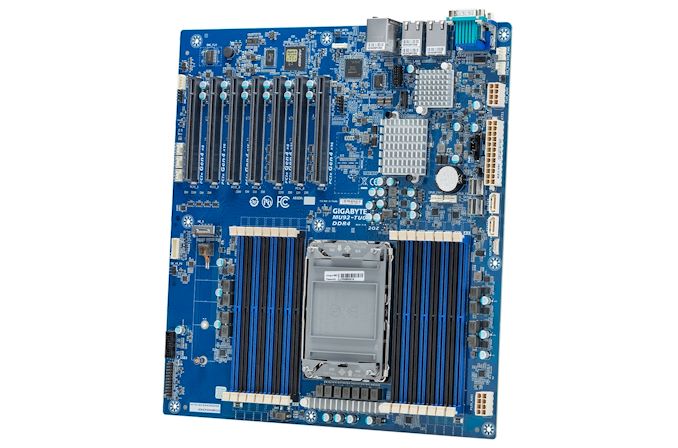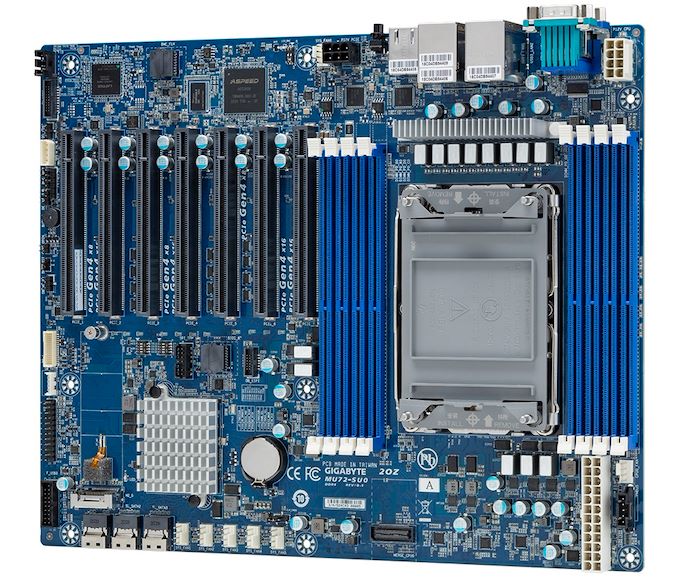GIGABYTE Server: Three New E-ATX Motherboards For Intel Ice Lake-SP Xeons
by Gavin Bonshor on April 6, 2021 4:00 PM EST
Hot on the heels of Intel's latest Ice Lake-SP 3rd Generation Xeon Scalable processor launch, GIGABYTE Server has listed three new motherboards designed for server use. The GIGABYTE Server MU92-TU1, the MU92-TU0, and MU72-SU0 all offer different levels of features and controllers and are based on Intel's C621A chipset for 3rd Gen Xeon Scalable. Two are built on the E-ATX form factor, with one ATX model, with features varying between sixteen memory slots, different dual Ethernet configurations, and all come with an integrated ASPEED BMC controller.
The Intel Xeon Scalable processor stack is designed for use in servers, with some likely professional applications alongside the usual Cloud and Datacenter operations. With some new refinements of its 10 nm process for Enterprise situations, including the use of SGX and a focus for customized crypto acceleration. There are many Intel Xeon Scalable Ice Lake-SP SKUs in the product stack, including the top tier 40-core Xeon Platinum 8380 model the way down to the entry-level Xeon Silver 4309 model.
Read our Intel 3rd Gen Xeon Scalable Review below:
To complement the 3rd Generation Intel Xeon Scalable for Enterprise launch, GIGABYTE has readied up three new motherboards. Based on the Intel C621A chipset and all using one LGA4189 socket, GIGABYTE Server MU92-TU0, the MU92-TU1, and MU72-SU0 include some interesting and notable features.
MU92-TU0 and MU92-TU1
Starting with the E-ATX sized pairing, the MU92-TU0 and MU92-TU1 both include seven full-length PCIe 4.0 slots, which can operate at x16/x0/x16/x0/x16/x0/x16, or x16/x8/x8/x8/x8/x8/x8, with sixteen memory slots that can support up to 2 TB of 3DS RDIMM/LRDIMM DDR4-3200 memory, with regular LRDIMMs of up to 128 GB and RDIMM memory up to 64 GB also supported. For storage, both the MU92-TU0 and MU92-TU1 include a single PCIe 3.0 x4 M.2 slot, with two SATA ports and two SlimSAS ports with support for up to eight SATA ports. Both models also include a standard 24-pin ATX 12 V motherboard power input, two 8-pin 12 ATX CPU power inputs, seven 4-pin fan headers, an Intel VROC connector, a PMBus, and an IPMB connector.

GIGABYTE Server MU92-TU0 motherboard (E-ATX)
Aesthetically the same with GIGABYTE's blue PCB, the only difference between the MU92-TU0 and MU92-TU1 is the MU92-TU1 is using ASPEED's latest ARM-based AST2600 BMC controller. The slightly lesser spec MU92-TU0 uses an ASPEED AST2500 BMC controller, while both models include dual 10 GBase-T Ethernet, which is powered by an Intel X710-AT2 controller. Also present on both models are two USB 3.0 Type-A ports, a D-Sub video output and MLAN port for the BMC, a COM port, and an ID button with LED.
MU72-SU0
The GIGABYTE Server MU72-SU0 is using an ATX form factor featuring a single LGA4189 socket. It includes eight memory slots, with support for up to 2 TB of 3DS RDIMM/LRDIMM DDR4-3200 memory, and regular LRDIMMs of 128 GB and RDIMMs up to 64 GB for servers that require less memory capacity. There's a total of seven full-length PCIe 4.0 slots, with supported configurations including both x16/x0/x16/x0/x16/x0/x16 and x16/x8/x8/x8/x8/x8/x8, with storage options including one PCIe 3.0 x4 M.2 slot, and three SlimSAS connectors which allow for up to twelve SATA ports.

GIGABYTE Server MU72-SU0 motherboard (ATX)
The MU72-SU0 uses an ASPEED AST2600 BMC controller, with a dedicated management Ethernet port and D-Sub video output, with dual Gigabit Ethernet, which is driven by a pair of Intel I210-AT Gigabit controllers. The rear panel also includes four USB 3.0 Type-A ports, a COM port, and an ID button with LED. Other avenues of connectivity around the board include seven 4-pin fan headers, a TPM header, and an Intel VROC connector. Providing power to the board is one 24-pin 12 V ATX motherboard power, one 8-pin 12 V ATX CPU power, and a 6-pin PCIe power input designed to deliver more power to the full-length PCIe slots.
It is unknown when the GIGABYTE Server MU92-TU1, MU92-TU0, and MU72-SU0 are likely to hit retail shelves at the time of writing, but given the Ice Lake-SP processors are now released, we don't expect it will be too long. We also don't currently have any pricing information.
Source: GIGABYTE Server
















10 Comments
View All Comments
meacupla - Tuesday, April 6, 2021 - link
why can't we get this ram layout with desktop mobos?DanNeely - Tuesday, April 6, 2021 - link
Assuming you're taking about the 8 dimm board, lack of clearance for anything but watercoolers probably. The large open area around the CPU socket on consumer boards is mandated by Intel (and AMD) to give room for larger tower heat sinks.meacupla - Wednesday, April 7, 2021 - link
I understand that, but it's not like the keep out zone for desktop sockets is so large that 4 RAM slots can't be rotated 90d to fitTheinsanegamerN - Wednesday, April 7, 2021 - link
That wouldn't fit int he standard 9.6" ATX width. The last boards that did that has significantly smaller CPU sockets and smaller cooler designs, EG socket 370DanNeely - Tuesday, April 6, 2021 - link
Are the the first two boards intended to be used with PCIe riser cables? The first 4 slots won't support anything bigger than a half length card before the CPU cooler or ram gets in the way.eastcoast_pete - Wednesday, April 7, 2021 - link
The last sentence unfortunately contains a key statement: no words on pricing yet. Please update when Gigabyte and others have MoBos with pricing - Thanks!eastcoast_pete - Wednesday, April 7, 2021 - link
With some IL Xeons now almost "affordable" (check the prices of some 24 core chips), those CPUs plus the right motherboard might make for good competitors to some Threadripper WorkstationsRobb1960 - Wednesday, April 21, 2021 - link
I'm wondering, anyone out there trying to link multiple 2demensional circuits across 3dimensions? Stacking multiple integrated circuits on top of each other, may exploit what engineers call "cross talk", otherwise called "noise" I only ask this question, because I come from the world of biology, neurology, and linguistics. Where things initially happen rather slowly, but at the end of the day, so many things (if there alive) are remarkably tough and robust.Robb1960 - Wednesday, April 21, 2021 - link
How to do this? I'm not an engineer (or play one on TV), so I don't see things as mathematical absolutes. Not 1's and 0's, yes or no, or simplistic digital mechanisms. Yes, digital technology has vastly improved our ability to process data. But it has not allowed us to differentiate data from information, or iniRobb1960 - Wednesday, April 21, 2021 - link
I want to propose, a way for our engineers to deal with the truly vast amount of communications we can suck up. Picture being in a huge auditorium, or conference room, or even a sports stadium. Ever wonder how among tens of thousands of individuals, each of us can selectively hear what one person says to us? Trying to ignore what someone says to you, and you DON"T want to hear them, is actually far more difficult to do. Honestly, is there anyone out there, who has had someone trying to talk to you, that you DID NOT want to hear?In communication's linguistics one way to understand the intent behind what some one is saying, is to introduce a "change agent" into the conversation. A person can introduce a subtle variable into a conversation that may change a subtle aspect of a conversation, but not effect the overall context of a conversation. With all we can "intercept", IMO, the more effective way is to apply certain "change agents" to what we listen to.